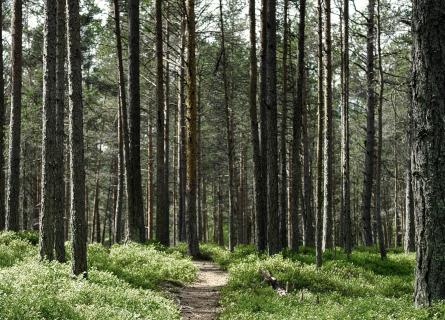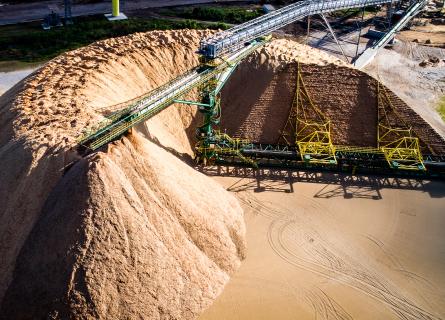
Bioeconomy – the new normal
Brussels, Stockholm, Helsinki, Dusseldorf… getting together in person is not easy these days. However, since meetings have gone digital in a big way, even an interview with long-time partners AFRY and the Confederation of European Paper Industries (Cepi) can be as easy as switching on the webcam. AFRY Insights had the pleasure of joining a screen-to-screen exchange with Cepi Chairman Ignazio Capuano and AFRY’s own CEO, Jonas Gustavsson, as they discussed their perspectives on the emerging bioeconomy.
“It simply takes common sense to understand how big the potential of bioindustry is in our efforts to mitigate climate change. However, the idea is not fully understood by everyone. This is why we need to construct a new narrative to describe and to discuss it” says Jonas Gustavsson. For several years now, Cepi and AFRY have been working closely together as partners, particularly in the areas of innovation and bioeconomy. But if reaching circular bioeconomy is common sense, how are these partners stepping up their support of the transition to bioeconomy?
Forest-based industries are playing a key role in the transition to a sustainable, climate-friendly bioeconomy. We provide fossil-free alternative solutions for many sectors: media, packaging, healthcare and hygiene, but also and increasingly for textiles. Cellulose-based materials might even replace the graphite used in portable technologies and the virtually limitless possibilities in biorefineries help us champion bio-based green chemistry, too. We are also the largest industrial generator and user of renewable energy in Europe
says Ignazio Capuano, underlining the importance of economic strength for the political implementation of a bioeconomy strategy. “Since 2010, we have invested twice as much as the other manufacturing sectors, and our investment has gone into Europe's bioeconomy, with 5 billion euros having been invested in 2019. Looking to the future, the European paper industry’s vision is to actively contribute to the EU 2050 climate neutrality targets, combined with a 50% increase in added value by 2050, which is possible under the right conditions. We are fully committed to this goal. By achieving our 2050 vision, we would become the European hub for the bio-based economy, integrating wood fibre, bio-based products, and circular economy. This would be an unbeatable combination for a greener and more resilient European economy.”
So, what about AFRY? Since ÅF and Pöyry joined forces more than one year ago, the new company AFRY has been a leader within the pulp and paper sector, as well as providing solutions and advice for the energy, infrastructure and industrial sectors. “We at AFRY see pulp and paper as the core of the core in our company. We have expertise in so many different sectors and areas, and right now the key is to take the right decisions to meet the challenges of our time, influenced by megatrends such as sustainability, climate change, urbanisation and digitalisation”, says Jonas Gustavsson. “And it is this wide scope in combination with our high-end strategic management consulting that allows us to provide the deep cross-sector expertise that can translate into the best value to our clients. So, more than anything, we want to expand and invest further. Why? Because our work is an important part of the transition to bioeconomy and, at the same time, it is good business.”
“Good business”, the right cue even from another point of view, for without economic growth and enhancing industry’s competitiveness it is almost impossible, even for politicians, to implement the pioneering reforms needed to unlock the full transition to bioeconomy. This is even more challenging if reforms have to be supported by the population. Based in Brussels, Cepi represents its members at the European institutions. At European level, the EU’s Green Deal governs the transition to bioeconomy. The EU’s Green Deal is the political programme of the von der Leyen Commission, which sets a target to reach a climate-neutral economy in 2050. As a result, we have seen the European Commission propose a climate neutrality law this year, formalising a legally-binding commitment to reduce greenhouse gas emissions to net zero by 2050. The Green Deal also foresees major initiatives impacting circularity, recyclability and sustainability of products on the EU market according to the Circular Economy Action Plan 2.0. “The role of the bioeconomy, thanks to skillful advocacy by Cepi, has been recognised within this ambitious climate neutrality plan, but will need to be further consolidated. Cepi is already working on elements that could become part of a modern Forest Strategy for Europe”, explains Ignazio Capuano.
From screen to screen, the interdependence of climate change issues quickly becomes clear, as does the need for all sectors of the economy and society to make a contribution towards building a better future. “With the young generation getting involved in the climate debate, not only is the discussion becoming more dynamic, but there is also a big hope that things will change. Of course, on the one hand I can understand a certain disappointment and even demotivation in people who expect more action from world leaders, because driving a circular bioeconomy requires brave political leadership. On the other hand, I see big companies starting to act, to change their products and services. And with people starting to buy climate-friendly products, things also start to change. In this respect, taxes and regulations also remain powerful tools for driving change”, says Jonas Gustavsson. “For companies, this change of course requires quite a bit of innovation and drive for cost-efficient solutions to be in a position to replace prevailing products with climate-friendly ones.” – “Exactly. To reach completely fossil free value chains, companies will need a plan for innovative solutions, with clear milestones for a timely and cost-efficient decarbonisation of the European energy system”, adds Cepi Chairman Ignazio Capuano.
But the great thing about our time is that sustainable solutions now go hand in hand with driving financial performance. More and more, it is becoming clear that as a company you can only be profitable and grow if you are compliant, have sustainability targets and offer sustainable solutions. And this is why I trust that the change will come
says Jonas Gustavsson.
If everyone has to be involved in solving the problem, how do leaders involve their employees and business community in their sustainability strategy? “As Cepi chairman, I can count on the support of a strong Board of Directors, consisting of 32 leading CEOs in the pulp and paper industry. The sustainability related decisions that we make have a direct impact on reality”, says Capuano.
“Cepi is a confederation of national pulp and paper industry associations that are able to engage each and every company at national level – covering 95% of the European production and 22% of the global production. Sometimes, finding common ground can take more time but we prefer working ambitiously on shared positions instead of opting for the easy way out of the ’lowest common denominator’. This has also gained Cepi a reputation among our stakeholders as a reliable and dynamic player.”
For Jonas Gustavsson, the question of AFRY’s sustainability strategy has different aspects. “One thing is for sure: we at AFRY will have a disruptive sustainability agenda, internally and externally. The merger has given us the opportunity to re-evaluate what the company stands for on a more fundamental level and we are currently in the process of finding ways to further measure sustainability in our company and identify how we can quantify our impact in all our products and in all the different segments we are operating in. We are finding out how we make sure that we as a company act in a sustainable way and how we can enable our employees to make a difference. At AFRY, we know that in order to attract the best people, sustainability will become even more important. We will be a loud voice, both in terms of knowledge and in terms of capabilities and delivery of sustainable solutions. That much is clear.”







